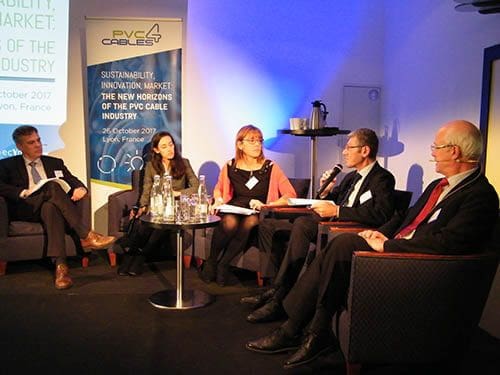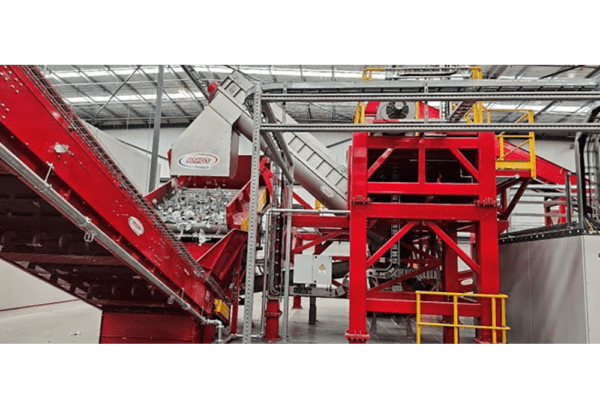
The European PVC Cables Sector Plugs into Innovation and Sustainability
PVC4Cables hosted its first conference ‘Sustainability, Innovation, Market: The new horizons of the PVC cables industry’ in Lyon, France, attracting more than 110 delegates from all over Europe.
Focus of the Conference was the significant progress made by the PVC cables industry in terms of sustainability and innovation, particularly thanks to the development of new formulations; and a factual debate on the impact of the European regulation on the market, notably in relation to CPR (Construction Products Regulation) and RoHS Directive.
“The wide participation of the European PVC cables value chain in this first PVC4Cables Conference is a very positive sign,” said Carlo Ciotti, PVC4Cables spokesperson, welcoming delegates. “It demonstrates that the whole industry is committed to supporting this important sector, sharing knowledge and experiences.”
In the opening session, Cristina de Santos of AMI Consulting, provided a comprehensive update on the PVC cables market and trends. Wires and cables represent today the largest application sector for flexible PVC in Europe, absorbing around 7% of the PVC resins manufactured and accounting for 46% of the cables market in Europe.
CPR, Euroclasses and additional criteria, test methods and CE marking were the themes covered by Roland Dewitt, ACCIPIS, who also set the scene for a stimulating discussion on the different implementation of CPR throughout the European countries. Experts from France, Germany, Italy and Spain underlined how implementation represents a concrete challenge for the European cables market. An update on RoHS and BEMP (Best Environmental Management Practice) was provided by Arjen Sevenster, Senior Manager at ECVM.
In terms of sustainability, significant steps forward have been made over the past decades thanks to the European PVC Industry’s Voluntary Commitments, which contributed to the progressive reduction of energy and resources consumption thus decreasing GHG (greenhouse gases) emissions; to the development of a new generation of PVC formulations; and to the development of collection and recycling schemes.
PVC cables represent today one of the main sources of recycled PVC, with more than 127,000 tonnes recycled from cables in 2016 within the VinylPlus® framework (www.vinylplus.eu), out of a total of 568,696 tonnes recycled. Novel technologies such as VinyLoop® have been developed to obtain high-quality recycled material. The update on PVC cables recycling provided by Francesco Tarantino, General Manager of VinyLoop®, concluded the Conference’s morning sessions.
Although considered mature, the PVC cables sector shows a vitality and dynamism capable of addressing major challenges and priorities in terms of sustainability, circular economy and performance. Innovation, in particular, in all its dimensions – polymerisation, additives, compounding, processing, recycling and end-uses – is at the heart of the PVC industry. It is estimated that more than 12,000 vinyl-related patents are issued in the world every year, as highlighted by Daniel Martinz, Technical Marketing and Development Manager, Specialty Vinyls at INOVYN, who presented new formulations and developments in relation to PVC resin performance. He added: “Innovation is in the heart of the vinyls industry. It is key for longevity.”
Professor Enrico Boccaleri, researcher at the Università del Piemonte Orientale (Italy), illustrated how the application of nanotechnologies to the PVC cables sector could bring improvements in thermal resistance, degradation and HCl emissions, while concrete examples of how R&D for new formulations can improve PVC cables’ fire behaviour were presented by Gianluca Sarti, of the PVC Forum Italia’s Compounds for Cables Group.
The afternoon sessions on ‘Innovation: solutions & possibilities’ were completed by an overview on the most recent developments in PVC additives, with presentations by Matthias Pfeiffer, European Plasticisers; Alain Cavallero, ESPA (European Stabiliser Producers Association); and Philippe Salémis, pinfa, the Phosphorous, Inorganic and Nitrogen Flame Retardants Association.
“These presentations and discussions demonstrated how R&D can bring major new developments to an application sector, like PVC cables, perceived as mature,” added Zdenek Hruska, PVC4Cables Project Manager. “We hope that an event like this can also facilitate networking and stimulate cooperation among the different components of the PVC cables value chain for further progress in innovation and sustainability”.





